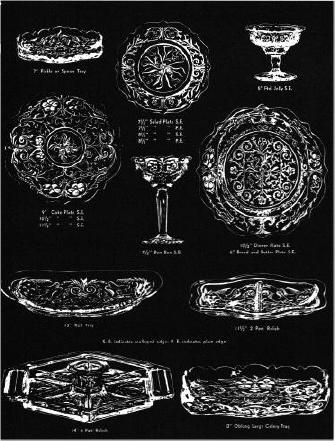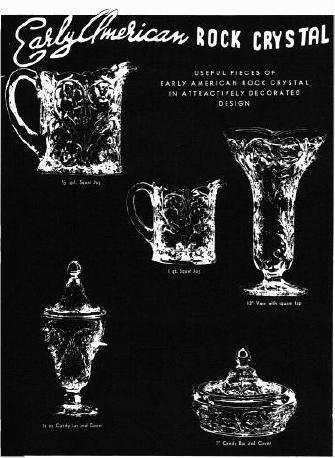National Depression Glass Association
Preserving America's Glass Manufacturing Heritage
The McKee Glass Company - Part I
by Sandra McPhee Stout
Rainbow Review Glass Journal - September 1972
The McKee Glass Company is one of our early glass factories whose
 origin dates to 1853 when the plant opened as McKee and Brothers in
Pittsburgh, Pennsylvania. The plant operated until the 1880 era, and
due to the resources of natural gas available 27 miles to the East, the
plant, men and moulds were moved by Mr. Henry Sellers McKee (owner and
president) to a site he named after his wile, Jeanette. (The name the
company is called today).
origin dates to 1853 when the plant opened as McKee and Brothers in
Pittsburgh, Pennsylvania. The plant operated until the 1880 era, and
due to the resources of natural gas available 27 miles to the East, the
plant, men and moulds were moved by Mr. Henry Sellers McKee (owner and
president) to a site he named after his wile, Jeanette. (The name the
company is called today).
The town, of course, wasn't even a town nor had it a name prior to he workmen moving there. The town population continued to grow and eventually the town became a populous of 1800. Today I believe the sign said 23,000 on the stake outside the city, however my memory may be wrong.
The 1890 times were hard. Being hit by the depression of that era,
the factories banded together with the National Glass Company. The
McKee plant was known. as the No. 12 (McKee) Plant. Mr. McKee was
removed from the scene when it was taken over by the National Glass
Company and a Mr. Andrew J. Smith, who also had his own glass company
when it was merged with National, was placed in charge of the McKee
plant and acted as the Manager-Foreman, answerable to the National
Glass Company. The National combine found it was expensively run, the
individual plants unhappy, and other assorted ails. Thus it was decided
in 1904 to disband, the companies being leased from National. The
current managers of the plants, wishing to rent the premises from
National, until each company had liquidated its debt to the point the
courts would allow each company to be sold, or further disposed of
under court. Mr. Smith ran the plant from 1904-10 as a receiver for the
company. in 1910 the court discharged Mr. Smith, as the debts of the
company were paid, and corporation papers were issued, with Mr. Andrew
 Smith now being president, and the Corp. was named The McKee Glass
Company. This position he held until his death in 1924.
Smith now being president, and the Corp. was named The McKee Glass
Company. This position he held until his death in 1924.
(The second installment of McKee Company history will be continued next month.)
Of the early patterns produced by the company, perhaps the best known today is ROCK CRYSTAL. It was issued early in 1904 in crystal as a Prescut line (that is, items will be found bearing the embossed prescut trade mark). It was continued until 1942 when it was finally discontinued. Only the items issued prior to 1930 will bear The prescut trade name however, Rock Crystal was issued continuously in crystal. During the 1925-29 period colors of green, rose-pink and amber were issued. Also a beautiful Ruby was issued approximately mid or late 1930, however, it was never reflected in the catalogs. Mr. Paul Sailer, whose father was Secretary of the McKee Glass Company and who has been with the McKee firm since a child, later becoming Vice President, Marketing and Sales, after the merger with Jeanette Co., owns a service for 12 in the Ruby which is truly outstanding.
When the Rock Crystal pattern was sold, every customer received a little pamphlet on Rock Crystal. It is printed here in its entirety with the gracious permission of Mr Paul G. Sailer who provided me with much information for my use, as I saw it to tell the story of McKee Glass Company.
THE HISTORY OF EARLY AMERICAN ROCK CRYSTAL GLASSWARE
Back in the 16th century, Rudolph II ruled over the destinies of the artistic carefree but progressive people of Bohemia. Rudolph was himself imbued with the fine cultural understanding of the famous artisans among his people, who were later to give the world many of its cultural traditions. It was at this time that the art of glass blowing and cutting began to interest the eager progressive people of Bohemia. Rudolph, not the least impressed by the magic of glass, called together his finest artisans and instructed them to produce the most beautiful sparkling glass tableware in the world to grace his kingly tables. Thus, the first designs were conceived and the first hand cuttings made of the now famous Rock Crystal. The monarch had kingly reason to be proud of the handiwork of his craftsmen, for as the centuries passed this masterly design found its way to America where American craftsmen improved the pattern adding new lustre and beauty. At the beginning of the 20th century, the idea came to the McKee Glass Company to produce Rock Crystal in a moulded glass. The faithful reproduction is both charming and distinctive, appearing to the most discerning lover of perfect table settings.
Rightly named EARLY AMERICAN ROCK CRYSTAL, this popular tableware has steadily gained in popularity - a bit of distinctive old world charm of early Bohemian origin.